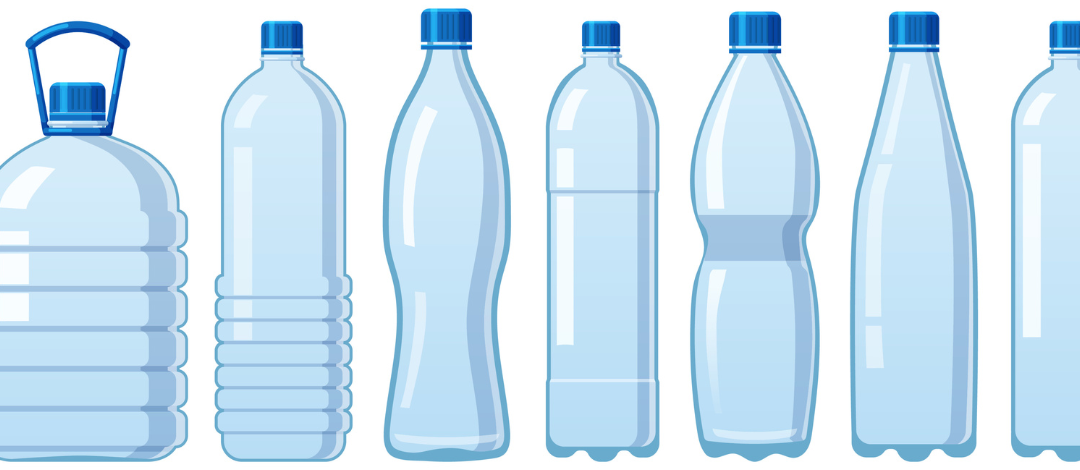
by Samantha Kennedy | Jul 19, 2024
As the summer sun blazes across the country, residents and visitors alike are reminded of the critical importance of staying hydrated. With temperatures soaring and humidity levels high, the risk of dehydration becomes a significant health concern. Proper hydration is not just a matter of comfort but a vital necessity to maintain health and well-being during the hot summer months.
The hot climate presents a challenging environment where dehydration can quickly set in, especially for those who spend a lot of time outdoors. Whether spending time at the beach, enjoying a theme park, or simply running errands, the intense heat can lead to rapid fluid loss through sweat. Dehydration occurs when the body loses more fluids than it takes in, and in Florida’s summer heat, this can happen faster than one might expect.
Dehydration can have serious health implications. Mild dehydration can cause symptoms such as dry mouth, headache, and fatigue. More severe cases can lead to dizziness, confusion, rapid heartbeat, and even heat stroke—a medical emergency that requires immediate attention. Children, the elderly, and individuals with chronic illnesses are particularly vulnerable to the effects of dehydration.
The body relies on water to perform critical functions, including regulating temperature, maintaining joint lubrication, and facilitating digestion. During hot weather, the body works harder to cool itself through sweating, increasing the need for water. Failing to replenish this lost fluid can disrupt these essential processes, leading to a range of health issues.
Need some tips for staying hydrated? Here are few simple ones.
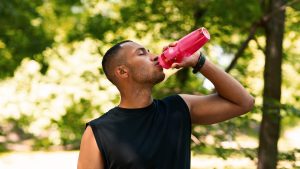
The heat and humidity of summertime increase the need for proper hydration, especially when outside. (Adobe Stock photo)
The most straightforward way to stay hydrated is by drinking water throughout the day. Carry a water bottle with you and make a habit of sipping regularly, even if the feeling of thirst is not strong. Thirst is a late indicator of dehydration, so proactive drinking is crucial.
Incorporate water-rich foods into your diet. Fruits and vegetables such as watermelon, cucumbers, oranges, and strawberries have high water content and can help keep you hydrated. They are also healthy choices that are rich in nutrients that can support overall health.
Both alcohol and caffeinated drinks can contribute to dehydration. While it is okay to enjoy these in moderation, be sure to offset them with extra water intake.
Urine color is an easy way to gauge overall hydration level. Light yellow or clear urine generally indicates proper hydration, while darker urine suggests that more fluids are needed for proper hydration.
Whenever possible, seek shade or air-conditioned environments during the hottest parts of the day. Wearing light, breathable clothing and a hat can also help reduce the risk of overheating and fluid loss.
Public parks, beaches, and recreational areas often have water fountains and hydration stations. Local health departments and organizations frequently run awareness campaigns and provide resources to educate the public about the importance of hydration.
Emergency services also stand ready to respond to heat-related health issues. Citizens are encouraged to look out for one another, especially vulnerable populations, ensuring that everyone has access to the necessary resources to stay hydrated.
As summer continues to heat up, the message is clear: staying hydrated is essential for enjoying all that Florida has to offer. By taking simple but effective steps to maintain proper hydration, residents and visitors can protect their health and fully embrace the sunny, vibrant Florida summer.
An Equal Opportunity Institution.

by Samantha Kennedy | Apr 22, 2022

Prudence Caskey, Santa Rosa County 4-H Agent. Photo source: UF/IFAS
Written by Prudence Caskey, Extension Agent II – 4-H Youth Development, UF/IFAS Extension Santa Rosa County
The hot Florida summer is approaching, and we all need to make sure we focus on hydration in the heat. Dehydration is very common in hot, humid environments. Many people do not drink the recommended amount of water. Many of us have our coffee in the morning and unless we go out to lunch and someone gives us water, we seldom think about water during the day. Another confusing concept is how much water we should drink. Growing up, we were told to get eight glasses of water a day. That is 64 ounces. Let’s see if that adage still holds true today.
How much water should I drink?
The best way to calculate how many ounces of water to drink is to multiply your weight by .67 or 67%. For example, a person weighing 150 pounds would need 100½ ounces or a little over 12½ cups. On the other hand, a person weighing 200 pounds would need 134 ounces or 16¾ cups.
Is that all the water I need?
No, as you sweat, you lose the water you have already consumed. If you are sweating for 30 minutes, you need to replenish your hydration with 12 additional ounces of fluid.
What fluid should I drink?
The main thing to remember when it comes to hydration is, just because it is wet does not mean you are being hydrated. Different fluids are absorbed by our bodies differently. Some alcoholic beverages remove hydration from our bodies as we drink them. Below is an example of how our bodies absorb some common beverages:
- Water absorbed at 100%
- Sparkling Water absorbed at 100%
- Skim Milk absorbed at 90%
- Buttermilk absorbed at 90%
- Whole Milk absorbed at 80%
- Apple Juice absorbed at 88%
- Decaffeinated Coffee absorbed at 90%
- Coffee absorbed at 80%
- Sports Drinks absorbed at 50%
- Energy Drink absorbed at 40%
- Wine absorbed at negative 150%
- Beer absorbed at negative 60%
- Sake absorbed at negative 180%
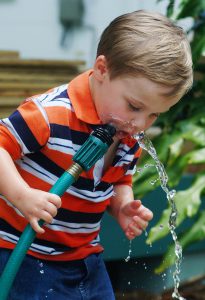
Staying hydrated in the heat of summer is an important part of sun safety. (Photo source: UF/IFAS File Photo)
- Liquor absorbed at negative 300%
This is a huge concept to grasp if you plan on being out at the beach with your friends this summer. With this example, a well-hydrated 150-pound person consumes the required 100½ ounces of fluid. Then, at a gathering, they have three glasses of wine. The standard five ounces per glass would mean they have removed 22½ ounces from their hydration after drinking only 15 ounces of wine. Be cognizant of what you add to your coolers this year.
What are the signs of dehydration?
There are many signs our bodies will give us to signal dehydration. Headache, nausea, and muscle pains are common. However, the most common sign of dehydration is thirst. That’s right, if you are thirsty, it is your body’s way of letting you know you need fluids. Just be careful which fluids you choose this summer when you are out enjoying the Florida sun.
Learn more at: https://edis.ifas.ufl.edu/publication/FY1409
UF/IFAS is an Equal Opportunity Institution.

by Ginny Hinton | Jul 5, 2019
Summer has hit the Florida Panhandle with a vengeance this year! If you’re out in the heat it’s especially important to make sure to keep your body well-hydrated. After all, water is the single largest component of our body, and it’s essential for life.
Recommendations for how much to drink vary depending on several factors including your age, how active you are, how hot it is outside, what you’re wearing, and if you have certain medical conditions. A pretty good “ballpark” from the Institute of Medicine Food & Nutrition Board (IOMB) is to drink around 3 quarts of water a day for women and around 4 quarts for men. It’s important to start hydrating even before your feet hit the floor in the morning, because your body has been losing fluid while you slept. And if you can go more than 4 hours during the day without taking a bathroom break, you’re probably already dehydrated.
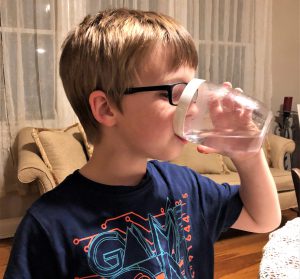
Water: Drink Up!
Photo Source: Ginny Hinton
Why worry about dehydration? In addition to making you more at risk of overheating, dehydration can affect a host of different organs and functions in your body. For example:
- Dehydration makes it harder for kidneys to flush toxins (poison) from your system, creating an infection-friendly environment.
- When you’re dehydrated, your blood becomes thicker and your heart has to pump harder to move it through your veins. This can lead to higher blood pressure.
- Dehydrated skin loses its elasticity and looks dry and flaky. Your sweat becomes more concentrated, making it harder for you to sweat as much as you need.
- Dehydrated joints are more brittle and more likely to become inflamed or damaged.
- When your body is low on water, it pulls too much liquid from the stool to use for other functions. That can cause constipation, in addition to inflammation throughout your body.
- Moist mucus membranes in the nose protect you from airborne allergens. Dehydration can dry them out and make you more vulnerable to irritating allergies.
- Dehydration makes you have less energy, and it also affects your mood and concentration. There’s a documented link between stress and dehydration.
The good news is that it’s easier to stay hydrated than you think. Water is a great way to hydrate, but it’s far from the only option. Watch the sugar and caffeine content when choosing other beverages, but milk, fruit juice, coffee and tea can all help you stay hydrated. The current guidelines to maximize the benefits and minimize the risks of caffeine intake are to drink no more than 1/3 to 4 cups of coffee per day (depending on the caffeine content) and 1 to 8 cups a day for tea. You can cut the sugar content but still have a tasty beverage by mixing half sweet tea with half unsweet, by mixing fruit juice with water, and by drinking flavored carbonated water with a splash of fruit juice to substitute for soda. Even food can help you stay hydrated! Watermelon, for example, is 90% water. Citrus fruits have a high water content as well, and vegetables like tomatoes, cucumbers and lettuce pack a powerful hydration punch.
As you get out and enjoy Florida’s sunny summer weather, just be sure to keep hydration in mind. Your body will thank you for it!
by Samantha Kennedy | Jul 25, 2018
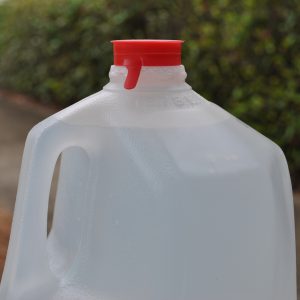
Commercially bottled water is a great choice for your emergency water supply. Store the bottles in a cool, dry place and have enough water on hand for each person (including pets) to have 1 gallon of water per day for 7 days. (Photo source: Samantha Kennedy)
Hurricane season is in full swing and will last through November 30. If you have not prepared your emergency supply kit, now is the time, BEFORE a hurricane is imminent.
The most important item in your emergency supply kit is clean drinking water. Clean water is essential for drinking, cooking, and basic personal hygiene during and after an emergency event.
You may stock up on clean water in one of two ways: by purchasing commercially bottled water from the supermarket, or by bottling it yourself.
If you purchase commercially bottled water, take heed of the use by date. While water does not spoil, per se, the quality of the water can diminish over time. The bottles may also start to break down as well, causing leakage or contamination. It is recommended to replace your emergency drinking water supply each year to maintain optimal safety and freshness.
Bottling your own water takes a little more effort, but can be just as safe as and will cost less than buying it commercially. Choose the proper containers. Glass may be sturdy, but it is heavy and can break, so use it sparingly. Plastic two-liter soda bottles and gallon-sized water jugs are ideal for storing water. Only use food-grade plastic containers and not containers previously used for chemicals such as bleach.
Sanitize the containers with a solution of 1 teaspoon of bleach per quart of water. Rinse the containers with clean water after sanitizing. Once the containers are filled with clean water, seal them with tight-fitting caps, label them as drinking water along with the bottling date, and store bottles in a cool, dry place.
Be sure to follow all boil water notices, especially if your water comes from a municipal source. If you get your water from a private well and are uncertain whether it is contaminated, it is better to err on the side of caution and boil water vigorously for 3 to 4 minutes before using it.
Boiling water is the most effective way to kill harmful bacteria that may be present. However, another effective means of purifying water is by adding bleach to the water. The type of bleach is important. Only use 5.25% household bleach free of perfumes, dyes, and color-safe or other additives. Eight (8) drops of bleach per gallon for clear water or 16 drops per gallon for cloudy water are the recommended amounts for effective purification.
How much water should you store in your emergency supply kit? At a minimum, one (1) gallon per person (including pets) per day for at least seven days is the recommended amount. This should be enough for drinking, food preparation, and basic personal hygiene. You may want to store more water as a precaution, if necessary.
For more information about preparing an emergency water supply, please refer to the UF/IFAS publication Preparing and Storing an Emergency Safe Drinking Water Supply.








